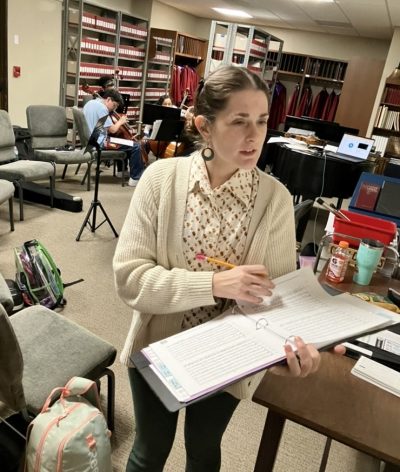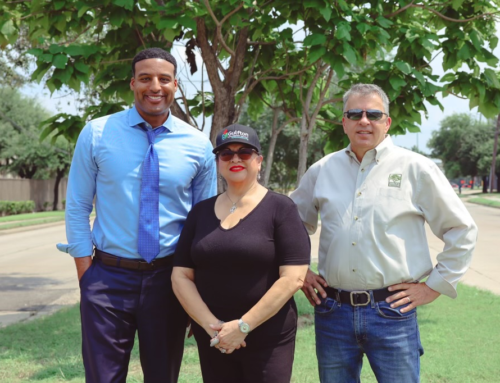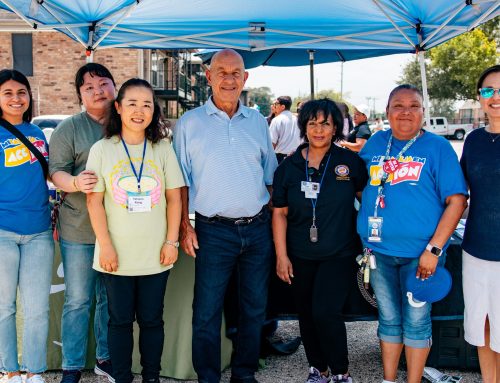 Ten years ago, Theodora Prunoske was looking for a change in her life. So, at 25, armed with a master’s degree in music, she left her job at a charter school in the South Bronx, bought a car and drove to Houston.
Ten years ago, Theodora Prunoske was looking for a change in her life. So, at 25, armed with a master’s degree in music, she left her job at a charter school in the South Bronx, bought a car and drove to Houston.
Her goal was to get a job teaching string music to young people.
She was determined to work in an underserved community where kids often lack opportunities to learn musical skills.
Her journey became the start of a slow but methodical effort to build a youth orchestra program in Gulfton from the ground up.
Now, as the founding director of the Gulfton Community Youth Orchestra, she is more dedicated than ever to broadening the musical horizons of the area’s students — while also teaching music, Spanish and visual arts at the private Kinkaid School.
The Gulfton work has been arduous and the gains have come slowly, but her single-minded effort appears to have earned her the loyalty of her students, the respect of their parents and the support of several community organizations.
After years of unpaid work — printing out handbooks, instrument rental forms and parent consent forms, often on her own dime — Prunoske now is being paid to run the orchestra.
Supporting her is Connect Community Gulfton/Sharpstown, a non-profit organization whose partners include KIPP Texas Public Schools, Legacy Community Health, St. Luke’s United Methodist Church, and the YMCA of Greater Houston. The goal of the non-profit organization is to address the needs of its community in education and other services.
The organization, at 6700 Bellaire Blvd., says it serves an area where 65 percent of the residents are from Latin America and 20 percent are from other countries around the world.
The community may not be the first place where some Houstonians would expect to find a community youth orchestra. But to Anne Whitlock, founding director of Connect Community, it seems natural that “students of different cultures and backgrounds (come) together through the beauty and universality of music.”
“In a time when schools have cut funding for the arts, community orchestras are critical for helping to build the leadership potential of our youth. Connect Community is proud to support the development of these amazing young people from Gulfton,” she said.
During COVID, when students were quarantined at home, Prunoske set up 30-minute Zoom lessons for every student, Monday through Friday. She printed out the musical scores they needed and dropped off “music care packages” at their homes along with a tuner and resin (for bows used to play classical string instruments).
Prunoske said the youth orchestra has a chamber ensemble of intermediate-level players. The GCYO also has just launched a vigorous expansion with two-hour instructional sessions every Tuesday and Friday from 5 p.m. to 7 p.m. at St. Luke’s United Methodist Church Gethsemane Campus, 6856 Bellaire Blvd.
Prunoske has also begun a novice strings and jazz program.

Theodora Prunoske, students & intensity
“We are getting students with no experience on an instrument to come in and begin playing a violin or cello,’ she said. “We will start with ‘how you hold the instrument’ and at the end we will have our spring concert.”
Prunoske has been teaching some of the students, now seniors in high school, for her ten years here, back to when she ran the music
program at KIPP. Her intermediate level students are now being given the responsibility of mentoring beginners.
Prunoske continues to set some high goals for the program, some of which, she admits, are rather lofty.
“In a dream world I would have a viola instructor and a cello instructor to help me out. I play both of the instruments but not as well as the violin, my main instrument.”
She also would like to have additional teachers to help out with sections of the orchestra.
And after years of printing out handbooks, music, parental release forms and instrument rental forms, often on her own dime, she would welcome administrative help.
“The part that I love is the teaching. The administrative part is just what you have to do to get there,” she said.
The orchestra has performed at the church and Whitlock’s home; now the goal is to perform on new stages.
In her first Houston years, Prunoske found that school music programs are not always a high priority, even at successful schools. Budgets did not exist for many music programs, including the acquisition of string instruments, which are extremely expensive.
But at the outset, Prunoske found ways to overcome some roadblocks.
Her first stop was at a KIPP primary school, 6700 Bellaire Blvd., part of KIPP Schools, a non-profit network of college preparatory schools that started in Houston and now operates more than 275 charter schools across the country.
To deal with the high overhead of string instruments, she started out with a ukulele ensemble, which she said are perfect for youth ensembles.
“I got a donation of 30 ukeleles for the kids and built the orchestra,” she said.
“They are easier to play than a guitar and they are so cheap to buy,” she said, “Someone can buy a $30 ukulele for themselves, attend a low-cost class and have music that would enrich their lives.”
Prunoske says she continues to have a good relationship with KIPP school and works with it through the GCYO. But she felt the school’s priorities were focused elsewhere.
During the school year after leaving KIPP School, Prunoske said, she started getting calls and texts from her former students and their parents: “They wanted to continue their music instruction and wanted to know how to do it,’ she said.
So Prunoske went to the Gethsemane Campus and got permission to use some of its classrooms for music practice two times a week.
And now, in addition to her full job, she is being paid by the Connect Community Gulfton/Sharpstown as the founding director of the Gulfton Community Youth Orchestra.
She sometimes wonders what would happen if someone stepped forward and offered to fund the youth orchestra program so she could work in Gulfton full-time.
“What would I do,” she said. “Because this is my baby… my heart project.”
— by Phil Shook






